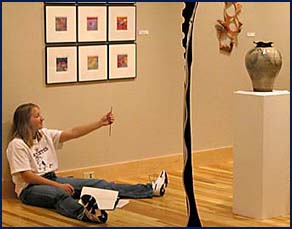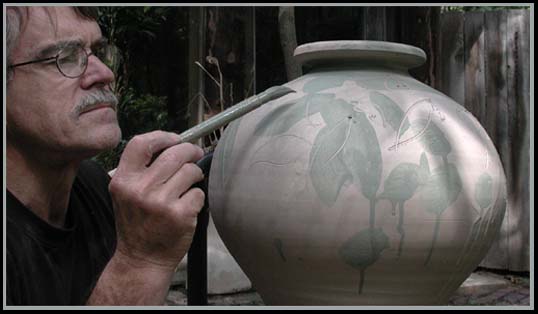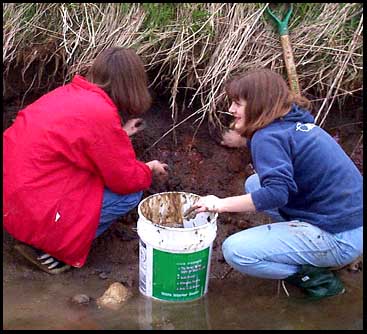the Problem
Too often, what is practiced in one lesson fails to carry over into other lessons.
These two comments from art teachers illustrate the point. The first is from a high school teacher and the second is from an elementary school teacher .
. . . I need a better lesson for sighting (and many other skills and concepts) . . . . the students seem to forget all of it as soon as we move on to something else. -- Pam Wellington, Art Dept. Chair, Boiling Springs High School, Pennsylvania
Sighting is commonly used by artists to determine size relationships, angles, etc. Some art teachers have found that using two crossing sighting straight edges (pencils, rulers, or just stips of matboard) help students see angles and perspective. One is held vertical or horizontal while the other sighting device is placed at the angle being observed.

Catie Froese uses a ruler to make sightings to determine proportions of a vase.
I just don't get it. My students can do wonderful drawings by observation, but when they work by imagination it often goes downhill!! They go back to stick figures! What is happening, and what can I do to help them? -- Betsy Braun, Art Teacher, OxBow Elementary, Concord Schools, Elkhart, Indiana
While these two teachers give examples related to transfer of learning in art, every teacher notices similar things happening. Transfer is at the core of creative thinking in every area. Facile transfer is a key ingredient in imagination. Imagination comes from minds that have fussy or leaky boundaries. These minds allow searches to flow between categories until relevant knowledge and creative ideas are discovered or invented. These minds expect to look beyond the typically mundane immediate instructions.
Why Be Concerned
Studies of highly creative adults have long shown that they are better at Similarities Catching, they are more Flexible thinkers, and they are more likely to consider Opposites. These are individuals that have proven themselves as inventors, composers, scientists, artists, and innovators.
Knowledgeable individuals that are also imaginative thinkers have the highest effective intelligence. They use the contents of their minds from any context and adapt it to problem or opportunity at hand. This is the essence of invention, problem solving, and innovation in every field - not just in art. Einstein said that imagination is more important than intelligence. The 9-11 Commission concluded that the failure of the United States to anticipate planes being used as weapons was a failure of the imagination. Lack of preparation and response to Katrina was a failure of the imagination.
It took me 40 years to notice that my last name had the word "art" in it. Apparently, my ability to do similarities catching was not well fostered in my own education.
How can a classroom be more deliberate in the nurture of this kind of transfer thinking? How can we become more proactive in our expectations for transfer of learning from one lesson to the next? While we need order and categories in order to make sense of what we know, we also need to learn the value of ignoring all conventional categories when we move into a creative mode. It takes imagination for our students to see these connections. Transfer of learning implies the ability to make connections between totally different situations and categories.
^ page top ^
Many jokes are based on similarities catching. The following is a comedic quote from Oscar Madison in Neil Simon's play: The Odd Couple
I can't take it anymore, Felix, I'm cracking up. Everything you do irritates me. And
when you're not here, the things I know you're gonna do when you come in irritate me. You leave me
little notes on my pillow. Told you 158 times I can't stand little notes on my
pillow. "We're all out of cornflakes. F.U." Took me three hours to
figure out F.U. was Felix Ungar!
http://www.imdb.com/title/tt0063374/quotes [copied 11-26-2010]
|
|
TEACHING for Stronger Thinking Habits
These are written for art teachers, but teachers in other areas will think of similar applications in their own disciplines. Many art teachers will think of additional ideas.
-
Make use of past lessons in unexpected ways
What if our projects, lessons, and assignments make a point of referencing prior learning? Most teachers do some of this. The more we do it, the more students will learn to have the basic expectation to make new applications of what has been learned earlier in order to make their current work better? What if we make a point of mentioning some prior learning that is not obviously relevant? Would this cultivate thinking habits that search a broader base of prior learning?
-
Awareness building
Could we use more questions during media work time that reference prior learning? What if we include some zingers (absurd, unrealistic, and fantastic connections)? Creative thinking habits can be nurtured. The critique process has fallen out of favor for may teachers because of negative experiences. There are positive critique strategies that can foster amazing awareness and discovery strategies.
-
Expectation building
What if each new skill is practiced and each new concept is learned with more emphasis (before, during, and after the experience) on how this experience will help us in the future? The teacher asks,"What are we learning today that will make every artwork we create in the future better?" We list responses on the board. Hype it more.
-
Recognition
What if we try harder to point out the surprising and possibly rare examples when a student does improve the work by noticeably using something learned in a previous lesson? We ask, "What do we see in this work that grows out of what we learned last week (last month, or last year)?"
-
Reflection
What if open questions are formulated and written down before, during, and after the media work? Both students and teachers could do this. What if some of these are used in a discussion so others begin to see and understand the type of thinking that is needed?
-
Identify Processes
We display work, but what if we also ask students to tell us how they came up with unique ideas? This allows us to affirm good methods and help the whole class. Others in the class may begin to imitate innovative thinking if they recognize successful methods of finding ideas in unexpected places in the mind. Can we ferret out and spread the secrets of artistic thinking?
-
Push Categories & Cross Boundaries
What if teachers in a school ask each other about the topics they are teaching so that they can encourage their students to look for ideas from other parts of their school day? What if students are asked to generate content and subject matter for their artwork that comes from a part of their lives that is generally not included in their artwork? What if they start by listing things about themselves they have never used before as subject matter? Post these categories of ideas for all to see.
-
Assessment
What if our rubrics acknowledge transfer of learning? Item: "Uses skills and knowledge gained in earlier assignments and other school subjects to noticeably improve the work of this assignment."
-
Written Assessment
What if tests are scored to give more credit to the most unique, or least frequently mentioned correct answer? What if tests include items that ask for new applications of materials and concepts studied? What if tests ask for opposites of the the correct answer - the most wrong answer? What if tests are given more credit when reasons for the answer are well stated.
Students who cannot write good responses may be unaware of the what a good response looks like. What if the most creative responses are posted (with permission from the writers) for the rest of the class to read?
Conclusions
Nurturing and changing thinking habits is perhaps the most significant thing a teacher can do. Unfortunately, thinking habits that facilitate good transfer of learning may be slow to change and difficult to influence. Too often we fall into practices that give quick results, but nurture thinking that is narrowly specialized, depends on imitation, on rote, or on following specific instruction. Is this education or some sort of training?
|
|


